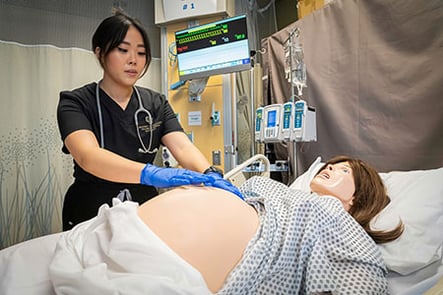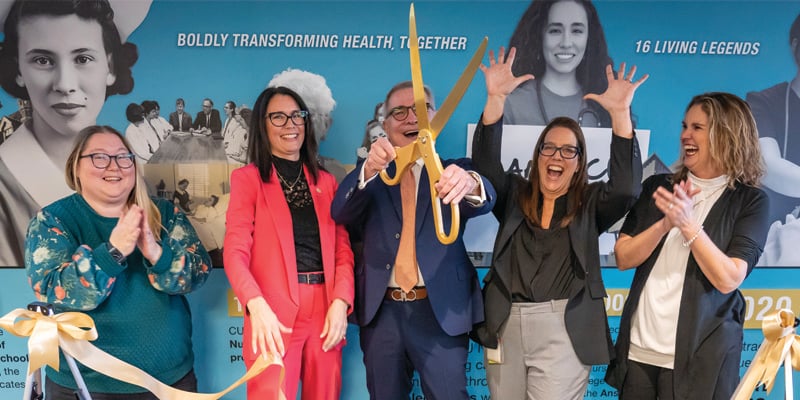This fall, more students than ever at the University of Colorado College of Nursing at the Anschutz Medical Campus will have access to state-of-the-art technology including AI, virtual reality, patient actors and high-fidelity medical manikins to practice their nursing skills and ultimately, improve health care. The students will be training in CU Nursing’s new, expanded, state-of-the art, simulation facilities. By adding nearly 15,000 square feet of space (14,901) at Anschutz Medical Campus and sim centers at Legacy Innovation Campus (also known as the South Denver location) and Fort Lewis College, CU Nursing will have the largest nursing simulation space in the Rocky Mountain region – 20,401 square feet – by 2024.
“This is a very large-scale investment from CU Nursing and our commitment to excellence in nursing education,” says CU Nursing Dean Elias Provencio-Vasquez, PhD, RN, FAAN, FAANP. “We are moving nursing education forward for our college through advancements in technology and other learning innovations.”
Provencio-Vasquez says advancing our simulation enterprise is one of CU Nursing’s strategic priorities, and the investment is a demonstration of the college’s commitment.
“This is a very large-scale investment from CU Nursing and our commitment to excellence in nursing education.” – CU Nursing Dean Elias Provencio-Vasquez, PhD, RN, FAAN, FAANP
CU Nursing is consolidating its other simulation facilities on the Anschutz Medical Campus and will run two facilities on the fourth and fifth floors of Education Building 1. Previously, the college managed a 3,000 square foot center on the third floor of the building. The new center is on the fourth floor and includes significant upgrades in state-of-the-art technology, lighting, flooring, ceiling tiles, and high-fidelity sound, along with 13,386 square feet of space. There will be another 1,515 square feet of simulation space on the fifth floor as well. The consolidation and expansion mean the college’s simulation services will be bigger, more comprehensive, and the majority of services will be available in one convenient location.
“This project is an upgrade in facilities and technology. It allows us to offer a more comprehensive simulation program to our students,” says Director of Experiential Learning at CU Nursing, Fara Bowler, DNP, APRN. “We have created a highly engaging, state-of-the-art facility that faculty, staff, and students can be proud of.”
CU Nursing’s Simulation Education = 20,401 square feet by 2024 |
|
Expansion details
The space was previously used by the University of Colorado School of Medicine, Center for Academic and Professional Excellence (CAPE), which moved its operations to the new Anschutz Health Science Building in early 2022. The vacated space was renovated for CU Nursing and tailored specifically to the college's needs. Meanwhile, the CU School of Dental Medicine moved to occupy CU Nursing’s former space with its own new, innovative simulation center.
Hands-on Learning
The new facility will allow learners to engage in multiple modalities of simulation.
One wing of the facility will include two formative learning simulation spaces where students engage in skill acquisition with dedicated task trainers, allowing the students to practice a skill set repeatedly, becoming more adept and comfortable over time.
The other wing of the facility will allow for innovative ways of learning. The multipurpose “Innovations Room” will be home to different technology – artificial intelligence, augmented reality with holograms, and simulated games. Students will wear headsets and become fully immersed in a virtual clinical environment. The entire space is being designed to engage students through a variety of simulation modalities, which allows for safe, controlled space for learning.

CU Nursing student practice skills on a pregnant manikin |
In the new center, students will also work with manikins to engage in a lifelike experience caring for patients. The manikins come in newborn to elderly sizes and vary in skin tone and gender. They each have a name, employment history, and full family background to simulate the complexities of today’s healthcare environment.
Computers, housed in the chests of the manikins, connect to laptops in the control room where faculty program and control the scenarios and the patient-manikin interactions. The manikins can sound like they are breathing, have heartbeats, and normal or spiking respiratory rates, and make bowel sounds. According to recent BSN graduate Taylor Santangelo, the manikins "can also blink, sweat, bleed, and talk. It's very realistic."
How simulation evolved
Simulation is a key component of CU Nursing’s education because studies show that simulation-based experiences enhance clinical competence, improve patient safety, and provide effective and accessible training to nursing students. A study by the National Council State Board of Nursing (2014) found that learning in simulation was equal, if not superior, to learning by traditional methods.
The Benefits of Simulation |
|
While simulation has been used in nursing education for many years, it wasn’t until the early 2000s that it became more commonplace. In 2007, the National League for Nursing (NLN) launched the Simulation Innovation Resource Center to promote the use of simulation in nursing education. The 2021 International Nursing Association for Clinical Simulation and Learning (INACSL) provides the Healthcare Simulation Standards of Best Practice to guide high quality and effective simulation.
Incorporating simulation into an educational curriculum assists students in developing clinical competence and confidence before working with real patients.
“I don’t think you could go to any college of nursing right now and not have some level of simulation,” Bowler says. “The point of simulation is to recreate situations where students can practice and learn from their mistakes. It creates a space where they can do things deliberately, repeating skills and clinical situations until they get them right.”
Simulation played a big role in helping CU Nursing and other colleges provide clinical learning during the pandemic. At the height of COVID-19 when students were quarantining at home and learning online, CU Nursing faculty expanded simulation training for students so they could still earn clinical hours and the ability to graduate. At the time, the Colorado Board of Nursing issued an emergency rule that allowed colleges to use 100% of the required clinical hours with well-designed, high-quality simulation. The new training model allowed students to transition into practice successfully.
Students from CU Nursing say simulation has been an essential part of their education. "Being able to put ourselves in a situation where we are forced to think critically and think about how we would act and react in a real-life scenario has been an invaluable experience," says Santangelo.
 CU Nursing students and faculty in simulation labs
CU Nursing students and faculty in simulation labs



